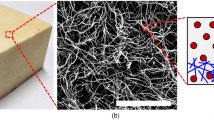Abstract
Mycelium is a biopolymer that has the potential to be a sustainable replacement for petroleum based foams in some engineering applications. During a recent study, with the objectives to first relate the effects of growing conditions on material properties and second to develop a model to predict the bulk behavior of mycelium, it was found that a variety of standard test methods are being used for the tensile characterization of mycelium in the literature. In the current study, these test methods were found to cause stress concentrations that resulted in maximum loads away from the gauge section, griping conditions that crushed the test samples through the thickness, and gauge sections that were smaller than the level of heterogeneity typically observed in samples of mycelium biopolymer. A new tensile specimen configuration has been developed that mitigates the issues associated with other specimen configurations. This new specimen configuration is used to determine the tensile strength, tensile modulus, and Poisson’s ratio of mycelium biopolymer specimens.









Similar content being viewed by others
References
Haneef M, Ceseracciu L, Canale C, Bayer IS, Heredia-Guerrero JA, Athanassiou A (2017) Advanced materials from fungal mycelium: fabrication and tuning of physical properties. Sci Rep 7:41292. https://doi.org/10.1038/srep41292
Tudryn GJ, Smith LC, Freitag J, Bucinell R, Schadler LS (2018) Processing and morphology impacts on mechanical properties of fungal based biopolymer composites. J Polym Environ 26:1473–1483. https://doi.org/10.1007/s10924-017-1047-9
Islam M, Tudryn G, Bucinell RB, Schadler L (2017) Morphology and mechanics of fungal mycelium. Sci Rep 7:13070. https://doi.org/10.1038/s41598-017-13295-2
ASTM D638-14 (2014) Standard test method for tensile properties of plastics. ASTM International, West Conshohocken. https://doi.org/10.1520/D0638-14
Van de Velde K, Kiekens P (2002) Biopolymers: overview of several properties and consequences on their applications. Polym Test 21(4):433–442. https://doi.org/10.1016/S0142-9418(01)00107-6
ASTM D882-12 (2012) Standard test method for tensile properties of thin plastic sheeting. ASTM International, West Conshohocken. https://doi.org/10.1520/D0882-12
Ceseracciu L, Heredia-Guerrero JA, Dante S, Athanassiou A, Bayer IS (2015) Robust and biodegradable elastomers based on corn starch and Polydimethylsiloxan (PDMS). ACS Appl Mater Interfaces 7(6):3742–3753. https://doi.org/10.1021/am508515z
Appels FVW, Dijksterhuis J, Lukasiewicz CE, Jansen KMB, Wosten HAB, Krijgsheld P (2018) Hydrophobin gene deletion and environmental growth conditions impact mechanical properties of mycelium by affecting the density of the material. Sci Rep 8:4703. https://doi.org/10.1038/s41598-018-23171-2
ASTM D3574-17 (2017) Standard test methods for flexible cellular materials—slab, bonded, and molded urethane foams. ASTM International, West Conshohocken. https://doi.org/10.1520/D3574-17
ASTME132-17 (2017) Standare test method for Poisson’s ration at room temperature. ASTM International, West Conshohocken. https://doi.org/10.1520/E0132-17
Acknowledgements
This material is based on work supported by the US National Science Foundation (NSF) under Grant No. CMMI 1362234.
Author information
Authors and Affiliations
Corresponding author
Ethics declarations
Conflict of Interest
On behalf of all authors, the corresponding author states that there is no conflict of interest.
Additional information
Publisher’s Note
Springer Nature remains neutral with regard to jurisdictional claims in published maps and institutional affiliations.
Rights and permissions
About this article
Cite this article
Bucinell, R., Keever, R. & Tudryn, G. A Novel Tensile Specimen Configuration for the Characterization of Bulk Mycelium Biopolymer. Exp Tech 44, 249–258 (2020). https://doi.org/10.1007/s40799-019-00348-6
Received:
Accepted:
Published:
Issue Date:
DOI: https://doi.org/10.1007/s40799-019-00348-6




